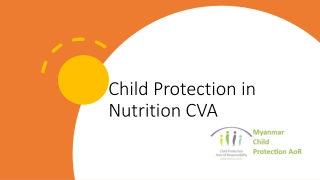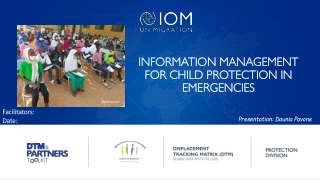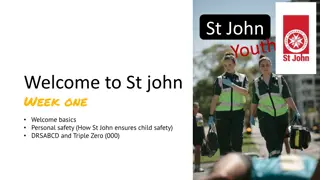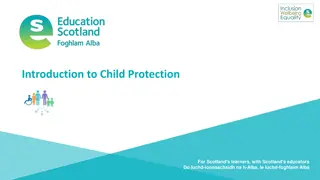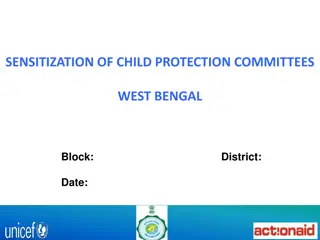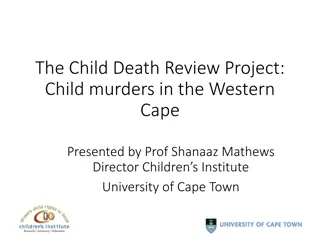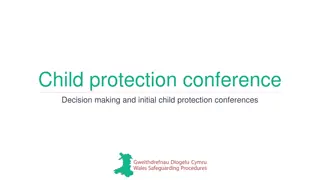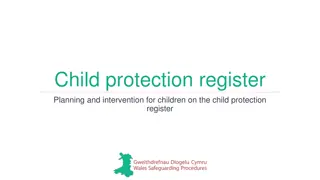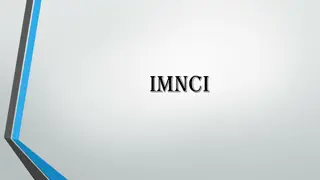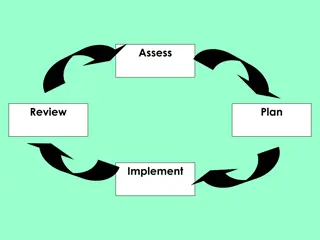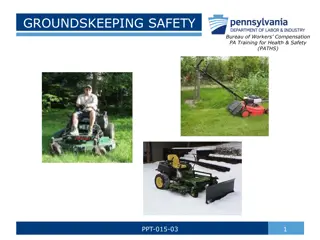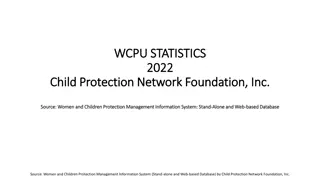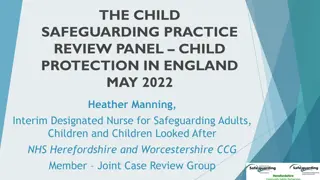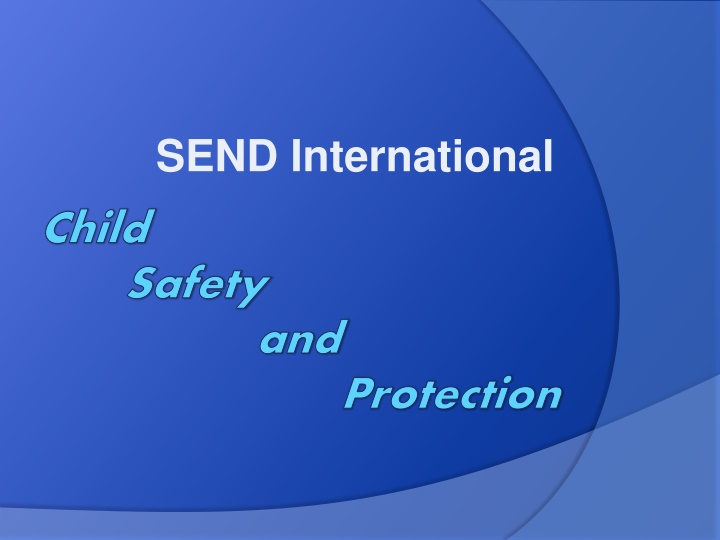
Child Safety and Protection Insights Around the World
Explore critical topics in international child safety and protection, including statistics on child abuse, historical responses to abuse incidents, and data from mission agencies. Learn about different forms of abuse, the importance of worker supervision, and key findings on abuse cases worldwide.
Download Presentation

Please find below an Image/Link to download the presentation.
The content on the website is provided AS IS for your information and personal use only. It may not be sold, licensed, or shared on other websites without obtaining consent from the author. If you encounter any issues during the download, it is possible that the publisher has removed the file from their server.
You are allowed to download the files provided on this website for personal or commercial use, subject to the condition that they are used lawfully. All files are the property of their respective owners.
The content on the website is provided AS IS for your information and personal use only. It may not be sold, licensed, or shared on other websites without obtaining consent from the author.
E N D
Presentation Transcript
SEND International Child Safety and Protection
Quiz 1. When is spanking a form of physical abuse? 2. What are examples of sexual abuse that don t involve touch? 3. Why is worker supervision so important? 4. Incidents of child sexual abuse peak between these ages: a) 1-5 b) 4-6 c) 8-12 d)13-16 e) 17-18 5. Most sex offenders have one victim: T or F 6. Abusers tend to move to inappropriate touching as soon as possible: T or F 7. What is the average age of a child s first exposure to pornography on the internet?
Child Abuse Statistics in the U.S. One out of five girls is sexually abused before turning 12 One of four before 18 One out of eight boys is sexually abused before turning 12 One of six before 18
Mission Agencies Historical Responses to Incidences of Child Abuse Na ve Ostrich technique Shhh keep it quiet Spiritualize it Things That May Contribute To Their Response Mission Policies Didn t understand the long term impact or risks Different laws / screening
Child Safety & Protection Network Data (CSPN) 342 Victims (18 agencies reporting) 381 Offenders (19 agencies reporting) 6
Kinds of Abuse (18 agencies reporting) neglect 1% inappropriate behavior (physical, emotional, neglectful) 2% physical and emotional abuse 7% emotional abuse 2% sexual abuse inappropriate sexual behavior physical abuse 10% physical abuse emotional abuse inappropriate sexual behavior 25% sexual abuse 53% physical and emotional abuse neglect inappropriate behavior (physical, emotional, neglectful) 7
Regions Where Cases Occurred Regions Where Cases Occurred (18 agencies reporting) (18 agencies reporting) 100 95 86 90 80 70 63 60 52 49 50 40 30 20 11 7 10 1 1 0 North America Central/South America Europe Africa Korea Other East Asia Countries* Central Asia** Australia, New Zealand PNG/other Pacific Island Nations *(India, Nepal, China, Tibet, Malaysia, Indonesia, Singapore, Japan, Cambodia, Vietnam, Thailand, Taiwan, Philippines, Laos) **(Pakistan, Afghanistan, former Soviet Union countries, Russia, Israel, Palestine, Turkey, UAE, Saudi Arabia, Yemen, Oman, Iran, Iraq, Jordan, Syria) 8
Ages of Victims (17 agencies reporting) (17 agencies reporting) Unknown 11% 0-3 14% 15-17 11% 4-5 11% 13-14 8% 0-3 4-5 6-9 10-12 13-14 15-17 Unknown 10-12 14% 6-9 31% 9
Reporting Laws * Michigan Child Protection Law, 1975 PA 238, MCL 722.621 et seq. Mandatory reporters include but are not limited to : physicians, psychologists, licensed counselors, school administrators / teachers / counselors, members of the clergy, law enforcement officers . * Act 238 of 1975 722.622 Definitions, Section 2 Member of the clergy means a priest, minister, rabbi, Christian science practitioner, or other religious practitioner, or similar functionary of a church, temple or recognized religious body, denomination or organization.
Definitions of Child Abuse Definitions of Child Abuse Child abuse is a corrupt practice or custom, which constitutes all forms of physical and/or emotional ill-treatment, sexual abuse, neglect or negligent treatment, or commercial or other exploitation, resulting in actual harm or could result in future harm to the child s health, development, or dignity, in the context of a relationship of responsibility, trust or power.
Definitions of Child Abuse Definitions of Child Abuse It refers to any act or failure to act that violates the rights of a child. Child abuse also has serious long term physical, spiritual and psychological consequences which may adversely affect health. Child means any person under the age of 18, and individuals over the age of 18 who continue to live with their parents due to special emotional, physical or psychological needs.
Sexual Abuse Verbal Visual Physical Touching
SEXUAL ABUSE SEXUAL ABUSE Verbal :Any form of verbal, written, or electronic communication, with the intent to arouse or stimulate, including sexual threats, innuendoes, comments about a person s body, solicitation, or sexually explicit language. Visual:Indecent exposure, showing or taking of suggestive pictures, peeping or leering. Visual sexual abuse also includes voyeurism, exhibitionism, producing or showing of pornographic material, of genitalia, or the showing of nude persons, and any sexual activity or simulated sexual activity such as masturbation or intercourse.
SEXUAL ABUSE SEXUAL ABUSE cont. cont. Physical touching: Fondling, sexual touching, masturbation in front of, or to the victim, rubbing, holding, and kissing for the purpose of sexual gratification. Further examples include oral, genital, anal and breast stimulation; penetration by penis, fingers, or any other body part or object, of mouth, anus, or vagina; physical contact with a person s clothed or unclothed genitals, pubic area, buttock(s), or breast(s), with the intent to arouse or gratify the sexual desire of either party.
Physical Abuse Action or Inaction which results in intentional physical injury. Lack of control by parent(s) or person(s) in a position of responsibility, power or trust. Physical abuse may include but is not limited to: burning, beating, slapping, throwing, biting, shaking, holding under water, pulling hair, kicking, punching or holding against one s will. Crossing a fine line
Emotional Abuse Emotional Abuse Actions towards a child that cause or have a high probability of causing harm to the child s health, physical, mental, spiritual, moral or social development Within the control of the parent or person in a relationship of responsibility, trust or power May include the failure to provide a supportive, developmentally appropriate environment Incidental vs. repeated
Physical Neglect Physical Neglect Failure to provide for needs
Other Other Child to Child Cases Abuse Inappropriate Behavior Dating Relationships A SEND member, employee or volunteer who is age 18 or older may not date someone age 17 or younger if there is more than three years difference in age
Possible Indicators of Child Abuse Possible Indicators of Child Abuse Sudden or unexpected changes, particularly after children have been visiting, attended camp, or attended another activity at which you were not in the immediate vicinity Indicators can be physical, behavioral, sexual, or verbal
Physical Indicators Lacerations, bruises, burns Discomfort when sitting Unexplained injuries
Behavioral Indicators Regressive behavior Eating problems Anxiety about going to school or nursery Sleep problems, nightmares
Behavioral Indicators Depression, sadness, being withdrawn Fearful of public restrooms or showering in PE Not wanting to be around certain people Not wanting to change clothes at a sleepover
Sexual Behavior Indicators Acting out sexual behavior Sexual behavior Compulsive masturbation Sexual promiscuity Displaying sexual knowledge through language or behavior that is beyond what is normal for their age Unusual or aggressive sexual play with other children
Verbal Indicators I don t like _________ does things to me when we are alone I don t like to be alone with___________ ____________ fooled around with me I don t feel good/ my stomach hurts, etc. Hints which can be indirect comments or statements about the abuse
Child Protection First Response Protocol Every Member 1) Take all reports of abuse or suspected abuse seriously 2) Seek medical attention if necessary for a current incident with injuries 3) Contact Director of Corporate Security, and the Area Director (AD) / Ministry Director (MD) 4) Complete Preliminary Report (CS & P Emergency Packet) and send to the Director of Corporate Security 5) Please - do not seek out additional information or attempt to investigate further on your own
First Response Protocol AREA Directors/Ministry Directors 1 ) Contact the Regional Director (RD) and Director of Corporate Security (DCS) who will contact the sending country AD 2 ) Report to other appropriate governmental authorities in compliance with local child protection laws where applicable 3) Upon consultation with the DCS, the alleged offender will be placed on administrative leave pending the outcome of an investigation 4) DCS will stress to involved leadership and reporter, confidentiality and perceived right to know as stated in the Child Protection Manual
Notification Procedure Notification Procedure (See Handout Packets)
Information Management Confidentiality
Confidentiality Confidentiality People believe they have a right to know People believe there is a need to know greater details to pray effectively People believe they need to identify other victims on their own without notifying the investigative team The alleged offender and the alleged offender s family may not want anyone to know There is often embarrassment on the part of the victim and the victim s family
What happens next? Local authorities will be notified according to local laws; and they may, or may not do an official investigation. An internal investigation WILL take place. This investigation will not impede any on-going official investigation.
Member Care Care for the alleged victim(s) & family Care for the alleged offender & family Financial responsibility Next : Action Plan Communication Follow-up care Responsibility for follow-up care
CODE of CONDUCT Discipline Appropriately Use Appropriate Touch Use Appropriate Verbal Interaction Transportation Safety Involve Parents / Guardians Maintain Visibility Minimize Isolation Provide for Accountability Inspect Regularly and Randomly Use Technology Appropriately
Protecting Children Protecting Children- - A Sacred Trust A Sacred Trust Parents, teachers, ministers, health care professionals, all of SEND International Teaching about stranger danger, crossing streets, fire prevention, bike safety, etc. Safety rules apply to ALL adults, not just strangers
What can YOU do to protect Children? Learn and understand the risks Minimize the opportunity Talk about it Stay alert, act on suspicions Get involved, it takes an entire community
Protecting children Teach about the touching rules Develop and maintain open lines of communication with your children. Remind the children they can tell you anything. Help children know they can help other children, i.e. reporting a bullying incident
Protecting Children Pay careful attention to persons around your children. Keep in mind that even "nice" people, people you trust, can do mean, hurtful or wrong things. Trust your instincts. Refuse to leave your children in the company of those you do not trust, no matter who that person is. Teach your children, as early as possible, to care for their own needs, such as bathing, dressing, and using the toilet. Give your children permission to refuse to obey an older child or adult if they believe what is happening is wrong. As always, talk to your children, and encourage them to talk to you. Listen to what they tell you.
Talking to older kids Be open and approachable Make sure they have the knowledge and tools they need. Help them understand healthy boundaries. Be straight about the facts- situations to avoid, understanding that most abusers are known, etc. Teach internet safety and savvy Start early and talk often Be proactive and tuned into your kids
Training Materials for Parents Training Materials for Parents I Said No! A kid-to- kid guide to keeping private parts private. Zack and Kimberly King. www.bouldenpublishing.com It s My Body Lory Freeman www.ParentingPress.com The Right Touch Sandy Kleven Illumination Arts Publishing Company These are books meant to be read with children: www.heroproject.org www.littlewarriors.ca

